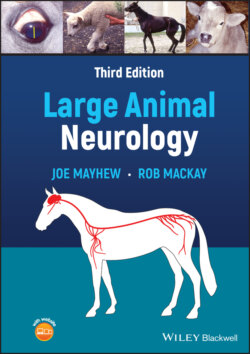Читать книгу Large Animal Neurology - Joe Mayhew - Страница 43
Hypoglossal nerve—CN XII
ОглавлениеThis last cranial nerve has its cell bodies in the hypoglossal nucleus of the caudal medulla oblongata. It is the motor nerve to muscle of the tongue. Thus, the tongue must be inspected for symmetry, normal movement, and evidence of atrophy. Normally, there is a strong resistance to withdrawing the tongue from the mouth in all species. A unilateral lesion of the nucleus or nerve results in unilateral atrophy of the tongue, with weak retraction; however, the tongue usually will not remain protruding from the mouth and cause minimal interference with eating and drinking. Bilateral involvement interferes with prehension and swallowing, the tongue usually protrudes, and the animal is not able to withdraw it back into the mouth. Horses that habitually play with their tongue using their lips and jaws are referred to as tongue chewers or tongue suckers and appear to have poor tone in this organ although it functions perfectly normally (Figure 2.13).
In adult large animals with a lowered mandible (dropped jaw), from say mandibular fractures or bilateral motor trigeminal lesions, the tongue can be seen to rest rostrally between the separated jaws. Also, with severe forebrain lesions that result in somnolence, but without focal brainstem involvement, the tongue may remain protruded and be slow to return to its normal position when pulled out of the mouth. This is the result of a lesion in the central motor centers in the forebrain or thalamus controlling hypoglossal function. The voluntary control pathways for function of the tongue are interfered with, without involving the hypoglossal nuclei or nerves, causing weakness without atrophy,
